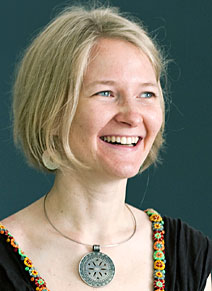Successful social movements, in hindsight, are almost always defined by the underdog—the disenfranchised overcoming the odds to secure new freedoms. Whether it’s the liberation movement led by Gandhi or the U.S. Civil Rights movement, all have one thing in common: the harnessing of the media, in some form, to aid in their cause. Ksenia Gorbenko, a Ph.D. candidate in sociology, has dedicated her graduate research to documenting the effect of these different forms of coverage, and is finalizing her dissertation, titled, “From Print to Pixel: Visual Media Technology and the Fate of Nonviolent Social Movement Activism.”
Gorbenko received her undergraduate degree in Russia before becoming an exchange student at the University of Arkansas. She then completed her master’s degree in Nationalism Studies at the Central European University in Budapest. She credits her diverse cultural experiences during her education for her decision to study sociology.
“The exchange program I was in while I was at the University of Arkansas was sponsored by the U.S. government; they wanted to bring students over from Russia and other parts of the former Soviet Union with the hope that they would return and push for democratization,” says Gorbenko. “And a lot of my peers actually did. Some of the friends I met through the program were later involved in organizing protests against rigged elections in Georgia, Kyrgyzstan and Ukraine in the early 2000s. So I became interested in social movements from a sociological perspective. ”
“There’s a lot of debate about how social media has revolutionized social movements, and the fact is, a lot of the reason it’s so effective right now is because it’s so new. Opponents of new mediums don’t know how the handle them, but in the end, the oppressors figure out a way to subvert the activists’ voices.” – Ksenia Gorbenko
In 2004, the Orange Revolution took place in Ukraine. Many of the contacts Gorbenko had made in school became personally involved. She decided to base her master’s thesis on their experiences, and from that point on she was hooked on understanding the inner workings of the different events and how the media influenced them.
The movements she focuses on in her dissertation include: the British women’s suffrage movement, Gandhi’s national liberation movements, the U.S. Civil Rights movements, the Moscow coup attempt of 1991, and the Orange Revolution. Though not unidirectional, the types of tactics activists used to bring attention to their situation were very similar, beginning with newspaper coverage and photos, then transitioning to television during the U.S. Civil Rights movements, and finally, as has been focused on during the recent uprisings in the Middle East, social media.
“Normally in a democratic society, you expect the people to enact change through voting, but for those who are disenfranchised, it’s a different story,” says Gorbenko. “For them, mass media is extremely important because if their plight isn’t brought to attention, no one will care. Unfortunately, the empowered citizens have the most access to the media, so movements have to adapt and strategize to get the word out.”
In the British women’s suffrage movement, the newspapers referred to the advocates of women’s votes as unfeminine and hysterical. One newspaper even referred to them as, “those harpies disgracing womanhood.” In contrast, other pictures showed them as well-to-do women looking prim and proper while being dragged away by police, which painted them in a sympathetic light. Eventually, though, both sides of coverage stopped because women were being jailed and force-fed during a hunger strike and they were unable to organize attention from the media.
This flip-flop by the media was also present during Gandhi’s time as an activist. Toward the beginning of the movement, Gandhi was boosted by footage of him speaking to media, but later, the British-run media would use voiceovers to discredit him. This coverage changed yet again after he died, when he was essentially held up as a god-like figure. Gorbenko says this is a trend that has been a constant throughout modern history—eventually the oppressors adapt to the disenfranchised groups’ use of the media and ultimately put an end to it. It’s a possibility even when it comes to multi-nodal forms like social media.
“There’s a lot of debate about how social media has revolutionized social movements, and the fact is, a lot of the reason it’s so effective right now is because it’s so new,” says Gorbenko. “Opponents of new mediums don’t know how the handle them, but in the end, the oppressors figure out a way to subvert the activists’ voices. Social media is particularly vulnerable in countries where internet use is controlled entirely by the government.”
Even though it can often be a struggle for the disempowered to retain objective coverage, a few powerful incidents changed culture almost instantly. One such event during the U.S. Civil Rights movement occurred when a television broadcast of a fictional movie about Nazis was interrupted by breaking news about the violence in Selma. The juxtaposition of the images of the oppressor helped mold public opinion from there out.
“As time goes on, it’s going to be a dynamic race,” Gorbenko says, “where technology is constantly trying to keep up. Journalists have a responsibility to be objective, and they usually stick to that because they want to appeal to current trending cultural movements, but since the disenfranchised rarely have any impact on advertising or power to network with powerful executives, the burden unfortunately lies with them to get their voices heard.”



